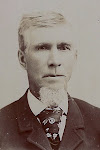Memorial Day Tribute
Published May 30, 2011
 Today is Memorial Day. It is a day to reflect and give thanks to those who served our nation in defense of our democracy. The 36 names that follow are greater Ducklow family members who where in the military and have since joined the Lord. I exhort you to take a minute to read the names to yourself and say a prayer of thanks for their service to our county.
Today is Memorial Day. It is a day to reflect and give thanks to those who served our nation in defense of our democracy. The 36 names that follow are greater Ducklow family members who where in the military and have since joined the Lord. I exhort you to take a minute to read the names to yourself and say a prayer of thanks for their service to our county.
Two of the 36 of this list where soldiers killed in action: Dwain Hanson, and Robert Francis Ducklow. Both were killed in WWII; Dwain as an infantry man during the Battle of the Bulge in Germany, and Bob as medic in the Pacific Theatre. The story of Dwain’s military service and death are posted elsewhere on this blog. I hope to learn more details of Bob's heroic story and publish them here. My prayers of gratitude to these men who scarified themselves for my freedom.
If you are aware of other members from the Greater Ducklow family that should be added to this list, please let me know. I wish to honor all in our family who served.
Melvin Clyde BLAIR
Served in US Army
WWII
Fort Snelling National Cemetery, Minneapolis, Minnesota
Milton “Buck” Charles BLAIR
Served in US Calvary
WWII
Roselawn Memorial Park Cemetery, Madison, Wisconsin
Eldon Dean CATURA
Served in the US Army
WWII
Riverside Cemetery, Withee, Wisconsin
William “Bill” Good CATURA
Served in US Army Signal Corp
WWII
Riverside Cemetery, Withee, Wisconsin
Evan Charles “Bud” DAVIS
Severed as Frogman in US Navy
WWII
Northern Wisconsin Veteran’s Cem., Spooner, Wisconsin
Arlin Dwain DUCKLOW
Served in US Army
Cuban Missile Crisis
Willow River Cemetery, Hudson, Wisconsin
Fay Ellsworth DUCKLOW
Served in US Army
WWII
Spring Lake Cemetery, Spring Valley, Wisconsin
Frank Erwin DUCKLOW
Served in the US Calvary
Spring Lake Cemetery, Spring Valley, Wisconsin
Frank Ruthbin DUCKLOW
Served in US Army
WWII
Sacred Heart Cemetery, Spring Valley, Wisconsin
George “Duck” William DUCKLOW
Served in US Navy
WWII
Resurrection Cemetery, Mendota Heights, Minnesota
George Nicholson DUCKLOW
Oak Hill Cemetery, Neenah, Wisconsin
Gerald Erwin DUCKLOW
Amery Cemetery, Polk County, Wisconsin
James Elmer DUCKLOW
Served US Army
St. Mary's Catholic Cemetery, Tomah, Wisconsin
John “Jack” Edward DUCKLOW
St. Josephs Cemetery, Sun Prairie, Wisconsin
Keith Ellsworth DUCKLOW
Served US Air Force - Entire Career
Cremated
Lamont Vernon DUCKLOW
Served US Army
National Memorial Cemetery Of Arizona, Phoenix, Arizona
Robert “Bob” Francis DUCKLOW
Resurrection Cemetery, Mendota Heights, Minnesota
Robert “Bob” Charles DUCKLOW
Highland Memorial Park, Appleton, Wisconsin
Thomas “Tom” Clayton DUCKLOW
Resurrection Cemetery, Mendota Heights, Minnesota
Victor “Vic” Neal DUCKLOW
Severed in US Marine Corp
St. John’s Cemetery, Spring Valley, Wisconsin
William “Bill” Thomas DUCKLOW
Cremated
Charles “Charley” J Francis GOOD
Served in Wisconsin Volunteer Infantry
Mount Hope, Ashland, Wisconsin
Francis Gerald “Gerry” GOOD
Highland Memory Gardens, Cottage Grove, Wisconsin
Glenn Merrill GOOD
Roselawn Cemetery, Monona, Wisconsin
James “Jim” Walter GOOD
Gordon Cemetery, Douglas County, Wisconsin
Budd John HANSON
Lakeside Cemetery, Cumberland, Wisconsin
Dewain Charles HANSON
American Cemetery, Luxembourg, Germany
Jerome “Jerry” Theodore John HANSON
Unknown Burial Location
James “Jim” F HOGAN
Copenhagen, Denmark
John “Jack” Good HOGAN
Mount Hope Cemetery, Ashland, Wisconsin
James Richard HOLMAN
Holy Cross Cemetery, Fargo, North Dakota
William Allan “Bill” HOLMAN
Riverside Cemetery, Fargo, North Dakota
Clair George “Red” LAGRANDER
Drain IOOF Cemetery, Drain, Oregon
John Neil LAGRANDER
Drain City Cemetery, Drain, Oregon
Mary Patricia “Mary Pat” REYNOLDS
Fort Snelling National Cemetery, Minneapolis, Minnesota
Alan Howard TORGERSON
Ames Cemetery, Ames, Iowa
❧












